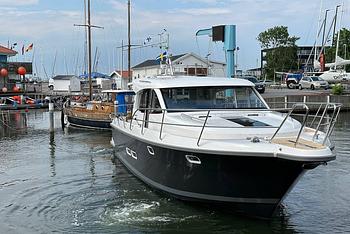Avoiding a collision when boating is among the most important responsibilities as captain of your vessel. Whether you run into another boat, hit the dock hard, run over a floating object, or run up on the rocks, a collision can be deadly. The US Coast Guard reported that of the 4,040 accidents that involved 636 deaths and 2,222 injuries in the United States in 2022: “Collisions…were the most frequent first event in accidents, attributing to 55% of accidents, 21% of deaths, and 53% of injuries.”
So what should you do to avoid colliding with another boat? Whether you’re driving a personal watercraft such as Jet Ski, a sailboat, or a cabin cruiser, the responsibility is on you as captain to ensure you take all appropriate action to avoid a collision. Taking a boating safety course is among the most valuable preparations you can undertake, and in many states in the US these are now required to get your boating license. Also important is to simply proceed with caution and develop good habits when operating a boat.
According to the US Coast Guard, the five main causes of boating accidents were due to operator inattention, operator inexperience, improper lookout, excessive speed, and machinery failure. So let’s consider these top 5 tips for avoiding boating collisions to help keep you safe on the water.

5 Tips for Avoiding Boating Collisions
1. Know the rules of marine navigation
Knowing the navigational rules is key to making the right decisions and avoiding collisions when boating. The Navigation Rules are published by the U. S. Government Printing Office and are available in your local boating supply store, or you can download a full PDF of the Navigation Rules here. (You should ensure your boat—whatever the size—has a copy on board and that you have studied the rules; it is mandatory that a copy be kept aboard all vessels over 39.4 feet in length.) The Navigation Rules cover steering rules, sound-signaling equipment and requirements, and a section on navigation lights. In the United States, they also distinguish between Inland Waters and bodies of water subject to the international navigation rules. Some of most important rules to know include:
- Paddle-powered boats and sailing vessels have, in most instances, right of way over powered vessels as they are less maneuverable. There are exceptions, however, including in an overtaking situation or when another vessel is unable to maneuver as it usually would. Essentially, the most maneuverable boat gives way.
- If you are overtaking another vessel, even if you are under sail, it is your responsibility to keep well clear of that vessel.
- When two boats under sail meet, the boat on a starboard tack has the right of way. When two sailboats are on the same tack, the leeward boat has the right of way over the windward boat. Check out our Top 6 Sailing Safety Tips for more information.
- When crossing, the boat approaching from starboard (right) has the right of way. It is your responsibility to slow down or take evasive action if you are on a collision course with that vessel.
- If you are approaching another vessel head-on, both boats must pass on the starboard side, allowing plenty of safe passing space.
- Keep clear of shipping lanes
- If you are approaching a vessel and you are not certain what its intentions are, slow down and take clear evasive action so that the other can understand what you are doing.
Sound Signals to Know to Avoid a Collision
- One blast: announces “I intend to pass you on my left (port) side”
- Two blasts: announces “I intend to pass you on my right (starboard) side”
- Three short blasts: signals “I am operating astern propulsion”
- One long blast: during times of limited visibility this is used at intervals of not more than two minutes and is the signal used by power-driven vessels
- One prolonged blast plus two short blasts: during times of limited visibility this is used at intervals of not more than two minutes and is the signal used by sailing vessels
- Five (or more) short blasts: signals immediate danger or that you do not understand another boat’s intentions, or that you disagree with what they’re doing and believe it to be unsafe

2. Keep to an appropriate and safe speed
Unlike on the roads, where speed limits are set in stone, there are fewer fixed speed limits on the water. That isn’t to say that there aren’t speed restriction areas, and it’s vital to adhere to any you see. When it comes to operating your boat at a safe speed, the most important point to remember is that any vessel should be operated at a speed that allows sufficient time and distance to take necessary action to avoid an accident or collision. You should:
- Always obey all traffic signs and signals, and don’t exceed any speed-limit restrictions
- When passing another vessel, ensure you keep a safe distance and that they can see you
- Never race another boat
- Never go above the manufacturer’s recommended speed limit for your vessel
- You and any passengers on board should always wear a life jacket
- Use a kill cord if your boat has one
- Don’t consume alcohol when operating any boat
- Don’t use a cell phone or text while operating your boat so you can remain focused at all times
Many factors play a role in determining an appropriate speed limit, including;
- The visibility
- The sea conditions
- The amount of boat traffic
- The type of boat you’re driving
- The water depth
- The passengers on board
For more information about safe boating speeds, see our guide to Boat Speed Limits: How Fast Should You Be Going?

3. Always maintain a watch or have a designated lookout
This is vital to ensuring you avoid a collision, and something that many boaters overlook. Before setting off you need to designate a lookout, who will keep an eye on the water and inform you, as captain, of any boats in the vicinity. You can do this yourself when operating a smaller boat, but on a larger vessel it’s a good idea to have some help. Ask them to look out for other boats, as well as any hazards in the water. You can have a rotation of lookouts if you’re going on a longer journey, but make it clear who is on duty and the importance of the role.
4. Stay focused and in control of your vessel
You’re the captain and it’s your responsibility to anyone on board your boat, as well as all other boats on the water, that you remain alert and in control of the vessel at all times. Avoid boating when you’re tired, stressed, or distracted, and never consume alcohol when in charge of a vessel. While it’s tempting to crack open a few beers at lunchtime, you’ll be cruising back to the slip or marina under the influence. According to the US Coast Guard, use of alcohol is the leading known contributing factor in fatal boating accidents; where the primary cause was known, it was listed as the leading factor in 16% of deaths. For more important tips on How to Keep Your Family Safe on Board, check out our in depth guide.
5. Research your cruising grounds and the weather before heading out
Do your homework before heading out for a day on the water. You need to know where you’re going and what the weather conditions may be, so you can be prepared for the unexpected. For example, if a squall appears ahead of you, where is the nearest harbor or how quickly can you get to your destination? Keep your VHF radio on when underway so that you can be alerted to any hazards ahead.
Check out our guide to Essential Boating Safety Tips for more ways to keep your family safe at sea.
What to Do If Your Boat is in a Collision?
It’s a scenario that no one ever wants to be in, but if the worst happens and you’re involved in a collision on the water, it’s helpful to know what to do, assuming you are still in the boat:
- Stop the engine immediately.
- Ensure all passengers on board are wearing life jackets in case the boat starts to sink or they must abandon ship.
- Check to see if anyone on board is injured and begin first aid to the best of your ability. Also ask the passengers of the other boat if they are injured. Contact emergency services by whichever means you have if someone is seriously injured. It may be a mobile phone, VHF marine radio, or satellite phone, and/or visual signals such as flares. Give a detailed description of your location, your boat, and who is onboard.
- Inspect your boat as best as you can to check for leaking or flooding. If you suspect that water is getting into your boat switch on the bilge pumps (if present), try to fix the leak, and/or use manual bilge pumps or bailers to slow down the water ingress.
- Exchange name, address, and boat identification with any other boat involved in the collision, and if possible take photographs. These are valuable when making an insurance claim (see our Guide to Marine Insurance for more information on the best policy to have).




